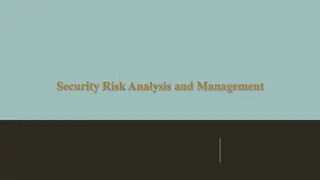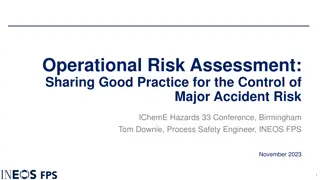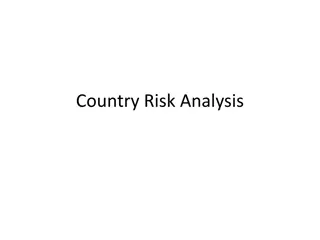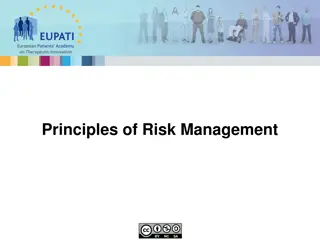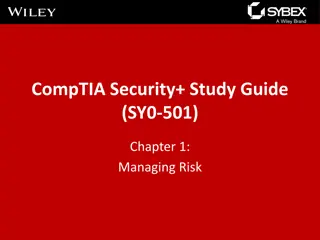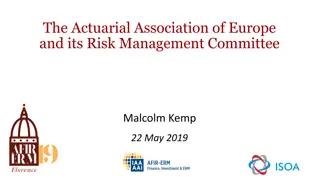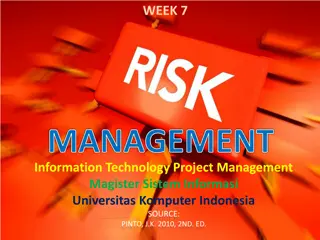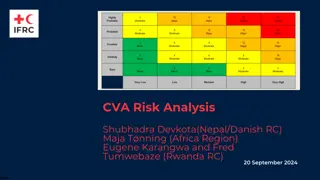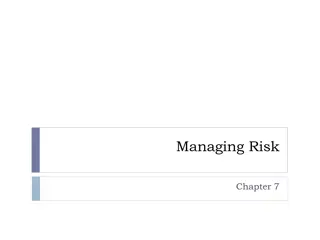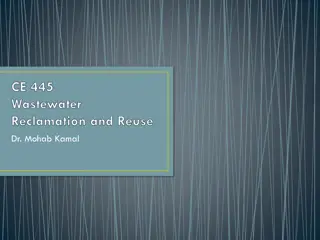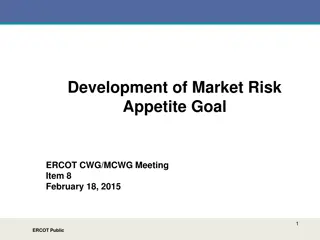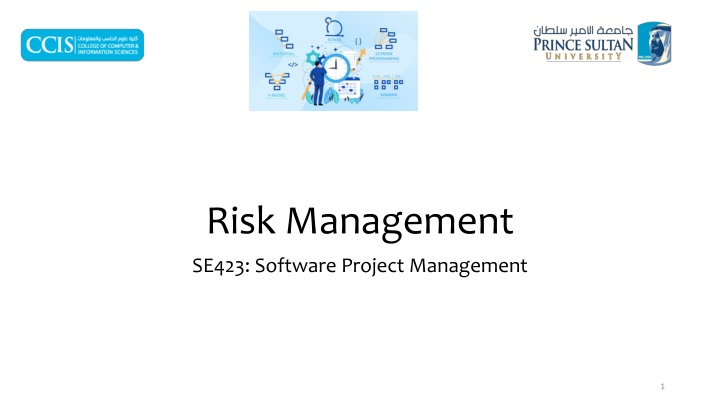
Risk Management
This content delves into the processes of risk management in software projects, covering risk identification, analysis, planning, and monitoring. It defines risks, explores proactive vs. reactive risk management, and outlines common project risks. The importance of understanding and addressing risks is highlighted, along with strategies for mitigating risks to enhance project success.
Download Presentation

Please find below an Image/Link to download the presentation.
The content on the website is provided AS IS for your information and personal use only. It may not be sold, licensed, or shared on other websites without obtaining consent from the author. If you encounter any issues during the download, it is possible that the publisher has removed the file from their server.
You are allowed to download the files provided on this website for personal or commercial use, subject to the condition that they are used lawfully. All files are the property of their respective owners.
The content on the website is provided AS IS for your information and personal use only. It may not be sold, licensed, or shared on other websites without obtaining consent from the author.
E N D
Presentation Transcript
Risk Management SE423: Software Project Management 1
Outline Risk Management Process Risk Identification Risk Analysis Risk Planning Risk Monitoring Strategies and Techniques 2
What is a Risk? Problems that haven t happened yet Characterized by: Uncertainty (0 < probability < 1) An associated loss (money, life, reputation, etc) Manageable some action can control it Needs to be actively identified and managed Some choose to ignore seen as negativity or too much worry Is a key element in project decision making especially important for the tough decisions Proactive vs. Reactive Active Risk Management is a sign of a well-run project and a mature organization 4
What is a Risk? According to the PMBOK Guide: Project risk is an uncertain event or condition that, if it occurs, has a positive or negative effect on one or more project objectives. A risk may have one or more causes, and, if it occurs, one or more impacts Project Risks What can go wrong? What is the likelihood? What will the damage be? What can we do about it? 5
Risk Classification Requirements Risks Incorrect Incomplete Unclear or inconsistent Volatile Cost Risks Unreasonable budgets Schedule Risks Schedule compression (customer, marketing, etc.) Quality Risks Life Cycle / Operational Risks Most of the Classic Mistakes 6
Risk Management Process Risk management is a systematic approach to reducing the harm due to risks, making a project less vulnerable to challenge or failure and its resulting product more robust Understanding the hierarchy of Risk Management = Understanding risks and how to deal with them 7
Reality check for your project plan Testing the plan before you begin Assessing the project using risk management Involving the team in planning Building confidence for your plan Selling the plan to relevant stakeholders 9
What can Possibly Go Wrong? Consider the average college student: What risks does the student encounter? How can we mitigate the damage? Computer related: Lose file; Lose flash drive; Lose hard drive; damaged Lose computer; damaged, lost or stolen Crash computer; corrupted files No network? Cannot access D2L Attendance and time management Miss class or late Late home work submission Miss home work submission 11
What can Possibly Go Wrong? Consider the average project: Testing takes longer than planned cannot resolve bugs Vendor cannot deliver a product on schedule Critical engineer Has accident (wipes out in ski jump) Becomes a parent Has major surgery Critical engineer leaves project/company Change of ownership. Project on hold Major downsizing Dysfunctional staff Blizzard and power failures 12
Risk Identification: Introduction Risk identification is concerned with determining what risks might have an impact on the project In addition, risk identification seeks to profile risks so that effective mitigation and response planning might be possible Risk identification is an iterative and incremental process that continually adds new risks, deletes non-risks, and refines existing risk profiles as the project progresses 13
How to Categorize Risk Risks: known, unknown, unknowable Known Risks: Risks that can be uncovered after careful evaluation of the project plan, business and technical environment, and other reliable sources of information (I.e. unrealistic delivery dates, lack of user input, etc.) Refer to those risks that can be estimated from historical information Can be mitigated by management techniques and through response plans, should they occur Example: Potential delay in delivery from third-party vendor Example: Key personnel leave project Example: Development systems down 14
How to Categorize Risk Predictable Risks [but unknown risks]: Risks that can be extrapolated from past projects. (Staff turnover, poor communication with the customer) Refer to those risks that we know have a probability of occurring, but do not know the precise impact Cannot be managed directly but can be mitigated by the use of contingency Example: Loss of key personnel due to turnover Unpredictable Risks Joker risks that are hard to predict. Unknowable risks Refer to those risks that are outside the scope of historical or probabilistic models for the project Are beyond the scope of risk management and usually are addressed by crisis or disaster management Examples: Corporate failures, natural disasters, acts of terrorism or war, major snowstorm and power loss 15
Risk management model (after Taylor) Qualitative Risk Analysis Risk Management Planning Risk Identification Quantitative Risk Analysis Tracking & Auditing (Risk History) Evaluate & Revise Risk Response Planning Risk Control Risk Monitoring 3/15/2025 16
Risk Identification Get the team involved in this process Don t go it alone Produces a list of risks with potential to disrupt your project s cost or schedule Use a checklist or similar source to brainstorm possible risks Use a SWOT analysis process 17
Risk Categories Types Classification Source Internal / Unique Classifications and Sources 18
Where risks are found Budgets/funding Schedules Scope or requirements changes Project plan Project management processes Technical issues Personnel issues Hardware Contracts Political concerns Business risk Legal risk Environmental risk 19
Three Types of Software Risk Project Risks Threaten the project plan. I.e. if the risks materialize, then it is likely that the project schedule will slip and costs will increase. Budgetary/funding Schedule Personnel issues Resources Project plan Project management processes Customers Requirements problems Scope or requirements changes Project complexity and size. Hardware Environmental risk 20
Three Types of Software Risk Technical Risks Threaten the quality and timeliness of the software to be produced. Design Implementation Interfacing Verification Cutover Maintenance Security 21
Three Types of Software Risk Business Risks Threaten the viability of the product to be built. Building a great product that no-one wants anymore. (Market risk) Building a product that no longer fits into the overall business strategy for the company (Strategic risk). Building a product that the sales force doesn't understand how to sell. Losing the support of senior management due to a change in focus or a change in people. (Management risk). Losing budgetary or personnel commitment (Budget risk) Contracts Political concerns Legal risk 22
Risk identification: tools and techniques Documentation reviews Effectively, a thorough review of all the inputs to the risk identification process Information-gathering techniques Brainstorming With right participants and proper facilitation, brainstorming is a self-regenerating process Delphi technique Employs a facilitator who distributes a questionnaire to participants and who compiles and synthesizes results Participants do not interact directly as they do in brainstorming Interviews Uses standard question and answer techniques with various stakeholders or anyone with project- relevant knowledge 23
Risk identification: tools and techniques Root cause analysis. Technique helps determine the source of risk Involves deep analysis of identified risks in order to root out other potential risks The source of risk may seem superficial and directly visible: simply, the most immediate source However, often the true source of risk its root cause is less obvious and not easily detectable Hall (1998) suggests using the Five Whys? approach Ask the question Why? five (more or less) times for each risk Each successive question moves closer to the root cause Not a highly robust method, but simple and effective 24
Risk identification: tools and techniques Root cause analysis (cont d) Example (based on actual case): O-O DB vendor is porting O-O DB to (our) new platform and has been identified as potential schedule risk Why? Vendor has requested additional time to deliver O-O DB Why? Vendor did not complete critical intermediate deliverable required for delivery Why? Vendor was unable to get concurrency (threads) to work properly Why? Vendor is using design from another platform with different OS Why? Vendor has no development experience programming with threads Note that this is a capability issue, not a technical issue! 25
Risk identification: tools and techniques Checklist analysis Based on historical information and previous project team experience requires one or more similar projects Risks can be compiled into a checklist Lowest level of the RBS can be used as a starting point for a checklist Checklists for projects cannot ever be exhaustive (remember, projects are unique) 26
Risk identification: tools and techniques Assumptions analysis Validates the assumptions identified and documented throughout the project planning processes Assumptions should be accurate, complete, and consistent Assumptions are tested against two factors: Strength or validity of the assumption Consequences to the project if assumption turns out to be false False assumptions should be reclassified as risks Diagramming techniques Cause-and-effect (fishbone or Ishikawa) diagrams System or process flowcharts Influence diagrams 27
Cause and Effect Diagram Also known as the Ishikawa (or fishbone) diagram Show the relationship between the effects of problems and their causes Depicts every potential cause and sub-cause of a problem and the effect that each proposed solution will have on the problem Useful as a tool for visually representing and capturing cause-and-effect relationships 28
Fishbone Diagram Moderator Planning Familiar with Process Ensure Key Particpants are Present Determine Particpants Select Trained Moderator Moderator Checklist Determine Number of Sessions Follow-up & Completion Ensure Procedures are Followed Determine if Overtime is Needed Schedule Meetings Effective Inspection Meetings Inspection Package Resolve All Major Defects List of Major Items for Discussion at Inspection Determine Defect Origin Inspectors Review Minor Error Defect Recording Log Ensure Coverage Preparation Inspection Meeting 3/15/2025 29
Risk owner notifies PM of event or risk trigger System or process flowcharts Decision Preparation symbol Risk response plan executed? Familiar diagram to most stakeholders Shows logical steps needed to accomplish an objective Shows how elements of a process or system relate to each other Depicts cause/response relationships Y N Response plan reviewed for effectiveness Review risk scores Process symbol Y N High risk score? Review risk and risk response plan Assign resources/ implement response plan Termination symbol Monitor response plan execution Document results 31
Influence diagrams Primarily used to show the causal influences among project variables May also show the sequencing of events Used to visually depict risks (or decisions), uncertainties or impacts, and how they influence each other Scope Quality Time Cost 32
Risk Identification Techniques Identification based on past experience. Identification based on historical data, perhaps through the use of a project database. Decision Driver Analysis, where the key decisions are examined for risk. The factors influencing decisions offer possible sources of risk. Threat identification in security risks 33
Risk Item Checklist A checklist is useful for supporting risk identification of known and predictable risks in the following subcategories: Product size risks associated with the overall size of the software to be built or modified. Business impact risks associated with constraints imposed by management or the marketplace. Customer characteristics risks associated with the sophistication of the customer and the developer's ability to communicate with the customer in a timely manner. Process definition risks associated with the degree to which the software process has been defined and is followed by the development organization. Development environment risks associated with the availability and quality of the tools to be used to build the product. Technology to be built risks associated with the complexity of the system to be built and the "newness" of the technology that is packaged by the system. Staff size and experience risks associated with the overall technical and project experience of the software engineers who will do the work. 34
Product Size Risks Project risk is directly proportional to product size. Measure the following sizes against previous projects. If those projects were successful & results are similar, then risk is probably low. If a large negative deviation is observed then risk is HIGH. Estimated size of the product in LOC or FP? Degree of confidence in estimated size estimate? Estimated size of product in number of programs, files, transactions? Percentage deviation in size of product from average for previous products? Number of users of the product? Impact on system (loading) Anticipated volatility of the requirements? Amount of reused software? 35
Business Impact Risks The following items help identify generic risks associated with business impact: Effect of product on company revenue. Visibility to senior management. Reasonableness of delivery deadline Number of customers who will use the product & consistency of their needs. Number of other products that it will interact with. Sophistication of end users. Governmental constraints. Costs associated with late delivery or a defective product? 36
Customer Related Risks The following items help identify generic risks associated with the customer: Have you worked with the customer in the past? Does the customer have a solid idea of what is required? Is the customer willing to commit significant time to the requirements gathering process? Is the customer willing to establish rapid communication links with the developer? Is the customer willing to participate in reviews? Is the customer technically sophisticated in the product area? Does the customer understand the software process? Risks should be investigated if the answer to any of these questions is NO . 37
Process Risks An ill defined software process and/or an ad hoc approach to analysis, design, and testing can introduce risk. The following are sample questions that should be asked to identify process risk: Do you have a consistent repeatable process that is actually used? Do you train all developers in the process? Are formal technical reviews part of this process? Do you have a mechanism for managing change? (i.e. formal RFC system + configuration management). Do you have specific methods that you use for each phase of the process? Is the process supported by tools? Do you manage the process through use of metrics? Risks should be investigated if the answer to any of these questions is NO . 38
Technology Risks Pushing the limits of technology is challenging & exciting, yet very risky. Questions to identify risk include: Is the technology to be built new to your organization? Do the requirements require the creation of new algorithms? Does the software interface with new or unproven hardware or unproven vendor products? Do the requirements require the creation of components that are unlike anything your organization has previously built? Do requirements demand the use of new analysis, design, or testing methods? Do requirements put excessive performance constraints on the product? Risks should be investigated if the answer to any of these questions is YES . 39
Development Risks The software engineering environment supports the project team, the process, and the product. If the environment is flawed, it can be a source of significant risk: Is a software project management tool available? Are tools for analysis and design available? Are compilers and code generators available and suitable for the product to be built? Are testing tools available and suitable? Are the software tools integrated with each other? Are team members trained in the use of the tools? Are tool mentors available? Risks should be investigated if the answer to any of these questions is NO . 40
Staff Size and Experience Risks CEOs have frequently observed that people make the most significant difference to the success of the organization. Are the best people available? Do the people have the right combinations of skills? Are enough people available? Are staff committed for the duration of the product? Are some people working on multiple projects? Have staff received necessary training? 41
Risk Components and Drivers The US Air Force requires project managers to identify risk drivers that affect software risk components. Performance risk the degree of uncertainty that the product will meet its requirements and be fit for its intended use. Cost risk the degree of uncertainty that the project budget will be maintained. Support risk the degree of uncertainty that the software will be easy to correct, adapt, and enhance. Schedule risk the degree of uncertainty that the project schedule will be maintained and that the product will be delivered on time. 42
Output: Risk Register The output of the Risk Identification process is the risk register All information gathered and generated during the Risk Identification process is documented in the risk register Risk register contains the following elements [and more]: List of identified risks List of potential responses Root causes of risks Updated risk categories Probability Impact Triggers 43
Risk Analysis Numerical analysis of risk allows: Make response decisions Determine overall project risk Add probability to predictions Prioritize risks Factor risk into cost, schedule, or scope targets Calculating Risk Exposure 45
Risk Analysis Risk Exposure Examples Facilities not ready on time Probability is 25%, size is 4 weeks, RE is 1 week Inadequate design redesign required Probability is 15%, size is 10 weeks, RE is 1.5 weeks How to Estimate Impact: The size of the loss break into chunks Probability: Use team member estimates and have a risk-estimate review Use Delphi or group-consensus techniques Use gambling analogy how much would you bet Use adjective calibration : highly likely, probably, improbable, unlikely, highly unlikely Sum all RE s to get expected overrun 46
How risk averse are you? Risk averse people: I like being dependable and I m usually punctual. I am not likely to take chances. I am responsible and prefer to work efficiently. I am more service oriented than self oriented. I value institutions and observe traditions Risk seeking people: I like action, and I act impulsively at times. I seek excitement for the thrill of the experience. I am resourceful and prefer not to plan or prepare. I am more self oriented than service oriented. I like to anticipate another person s position. Risk neutral people: I trust my intuition, and I am comfortable with unknown. I think about the future and have long-range objectives. I am naturally curious and often ask, Why? I enjoy generating new ideas. I work best when I am inspired. 3/15/2025 47
Elements of Risk Analysis What are the risks involved in getting to work? Reduce the occurrence and/or impact of the risk. Identify new risks as they occur & report on all known risks. 48
Risk Management Risk assessment Objectives Analyze risk in a cost-efficient manner Determine source of risk Determine risk exposure Determine time frame for action Determine highest-severity risks 49
Assessing Project Risk Have top software and customer managers formally committed to support the project? Are end-users enthusiastically committed to the project and the system/product to be built? Are requirements fully understood by the software engineering team and their customers? Have customers been involved fully in the definition of requirements? Do end-users have realistic expectations? Is project scope stable? Are project requirements stable? Does the software engineering team have the right mix of skills? Does the project team have experience with the technology to be implemented? Is the number of people on the project team adequate to do the job? Do all customer/user constituencies agree on the importance of the project and on the requirements for the system/product to be built? 50

